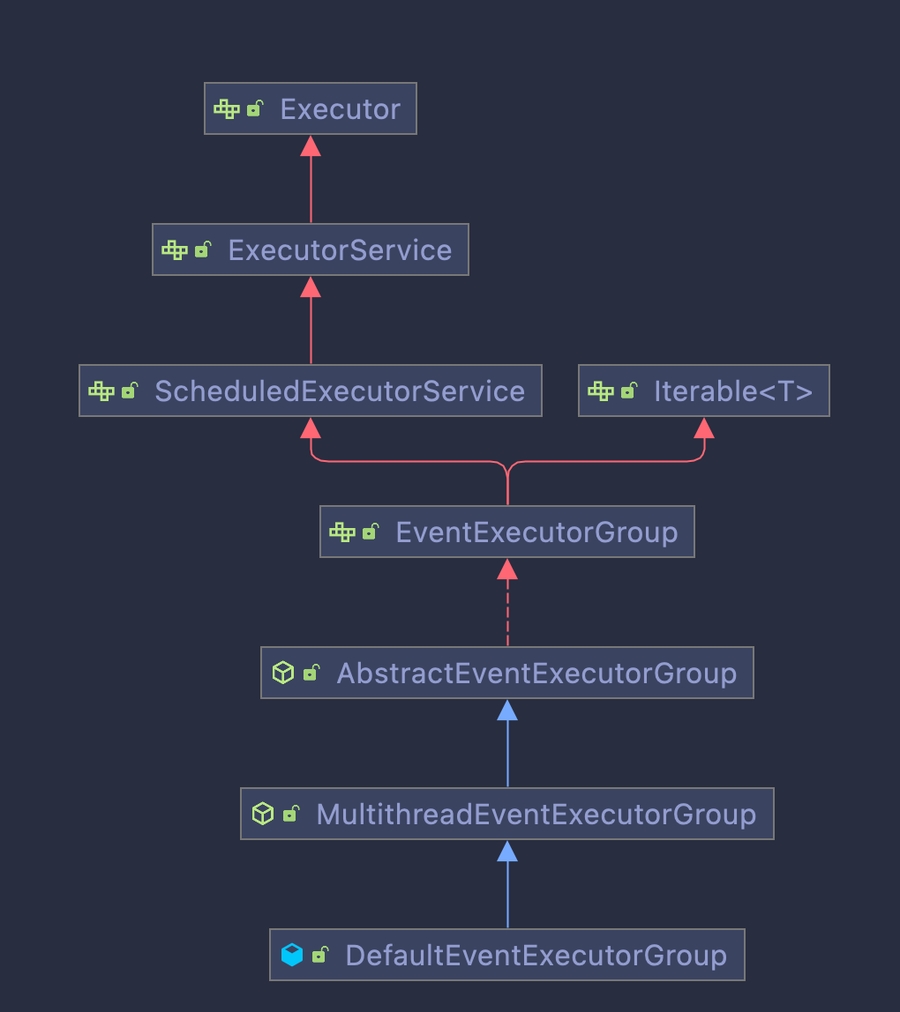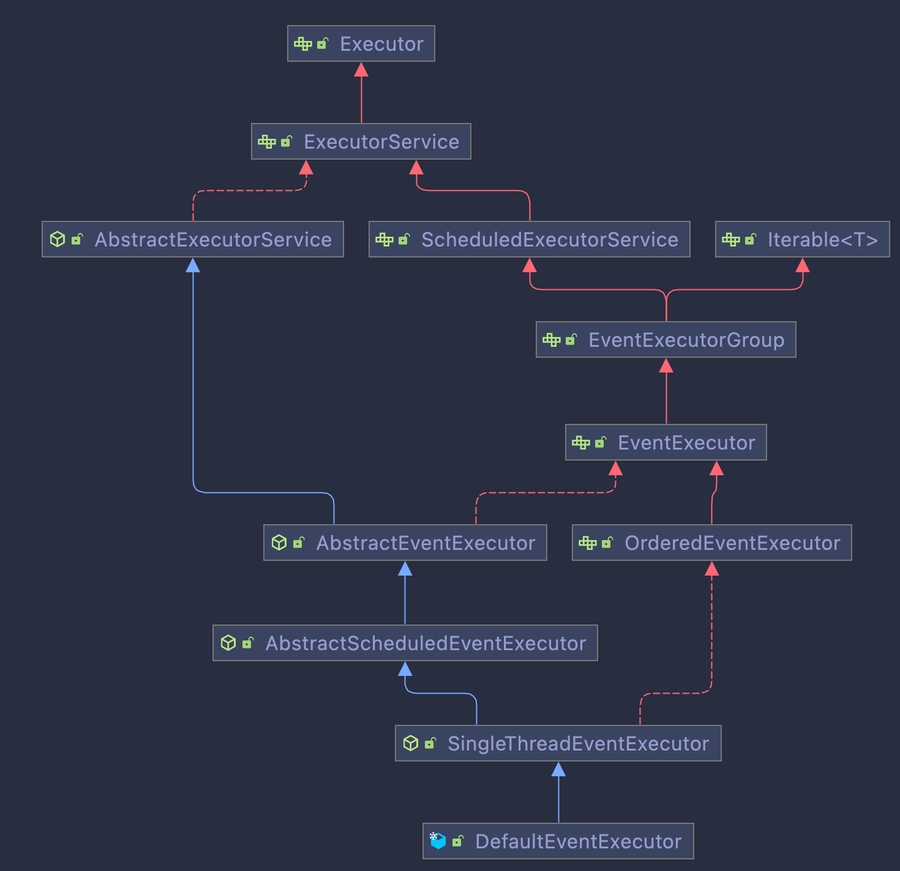05-netty-EventExecutor-EventExecutorGroup
12. netty系列之:EventExecutor,EventExecutorGroup和netty中的实现
简介
netty作为一个异步NIO框架,多线程肯定是它的基础,但是对于netty的实际使用者来说,一般是不需要接触到多线程的,我们只需要按照netty框架规定的流程走下去,自定义handler来处理对应的消息即可。
那么有朋友会问了,作为一个NIO框架,netty的多线程到底体现在什么地方呢?它的底层原理是什么呢?
今天带大家来看看netty中的任务执行器EventExecutor和EventExecutorGroup。
EventExecutorGroup
因为EventExecutor继承自EventExecutorGroup,这里我们先来详细讲解一下EventExecutorGroup。
先看下EventExecutorGroup的定义:
public interface EventExecutorGroup extends ScheduledExecutorService, Iterable<EventExecutor>EventExecutorGroup继承自JDK的ScheduledExecutorService,即可以执行定时任务,也可以像普通的任务执行器一样提交任务去执行。
同时EventExecutorGroup还继承了Iterable接口,表示EventExecutorGroup是可遍历的,它的遍历对象是EventExecutor。
EventExecutorGroup有两个和Iterable相关的方法,分别是next和iterator:
EventExecutor next();
@Override
Iterator<EventExecutor> iterator();在EventExecutorGroup中调用next方法会返回一个EventExecutor对象,那么EventExecutorGroup和EventExecutor是什么关系呢?
我们再来看一下EventExecutor的定义:
可以看到EventExecutor实际上是EventExecutorGroup的子类。但是在父类EventExecutorGroup中居然有对子类EventExecutor的引用。
这种在父类的Group中引用返回子类的设计模式在netty中非常常见,大家可以自行体会一下这样的设计到底是好还是坏。
EventExecutorGroup作为一个EventExecutor的Group对象,它是用来管理group中的EventExecutor的。所以在EventExecutorGroup中设计了一些对EventExecutor的统一管理接口。
比如boolean isShuttingDown()方法用来判断这个group中的所有EventExecutor全都在被shutdown或者已经被shutdown。
另外EventExecutorGroupt提供了shutdown group中所有EventExector的方法:Future<?> shutdownGracefully() 和 terminate方法:Future<?> terminationFuture()。
这两个方法都返回了Future,所以我们可以认为这两个方法是异步方法。
EventExecutorGroup中其他的方法都是一些对JDK中ScheduledExecutorService方法的重写,比如submit,schedule,scheduleAtFixedRate,scheduleWithFixedDelay等。
EventExecutor
接下来我们再研究一下EventExecutor,在上一节中,我们简单的提到了EventExecutor继承自EventExecutorGroup,和EventExecutorGroup相比,EventExecutor有哪些新的方法呢?
我们知道EventExecutorGroup继承了Iterable,并且定义了一个next方法用来返回Group中的一个EventExecutor对象。
因为Group中有很多个EventExecutor,至于具体返回哪一个EventExecutor,还是由具体的实现类来实现的。
在EventExecutor中,它重写了这个方法:
这里的next方法,返回的是EventExecutor本身。
另外,因为EventExecutor是由EventExecutorGroup来管理的,所以EventExecutor中还存在一个parent方法,用来返回管理EventExecutor的EventExecutorGroup:
EventExecutor中新加了两个inEventLoop方法,用来判断给定的线程是否在event loop中执行。
EventExecutor还提供两个方法可以返回Promise和ProgressivePromise.
熟悉ECMAScript的朋友可能知道,Promise是ES6引入的一个新的语法功能,用来解决回调地狱的问题。这里的netty引入的Promise继承自Future,并且添加了两个success和failure的状态。
ProgressivePromise更进一步,在Promise基础上,提供了一个progress来表示进度。
除此之外,EventExecutor还提供了对Succeeded的结果和Failed异常封装成为Future的方法。
EventExecutorGroup在netty中的基本实现
EventExecutorGroup和EventExecutor在netty中有很多非常重要的实现,其中最常见的就是EventLoop和EventLoopGroup,鉴于EventLoop和EventLoopGroup的重要性,我们会在后面的章节中重点讲解他们。这里先来看下netty中的其他实现。
netty中EventExecutorGroup的默认实现叫做DefaultEventExecutorGroup,它的继承关系如下所示:

可以看到DefaultEventExecutorGroup继承自MultithreadEventExecutorGroup,而MultithreadEventExecutorGroup又继承自AbstractEventExecutorGroup。
先看下AbstractEventExecutorGroup的逻辑。AbstractEventExecutorGroup基本上是对EventExecutorGroup中接口的一些实现。
我们知道EventExecutorGroup中定义了一个next()方法,可以返回Group中的一个EventExecutor。
在AbstractEventExecutorGroup中,几乎所有EventExecutorGroup中的方法实现,都是调用next()方法来完成的,以submit方法为例:
可以看到submit方法首先调用next获取到的EventExecutor,然后再调用EventExecutor中的submit方法。
AbstractEventExecutorGroup中的其他方法都是这样的实现。但是AbstractEventExecutorGroup中并没有实现next()方法,具体如何从Group中获取到EventExecutor,还需要看底层的具体实现。
MultithreadEventExecutorGroup继承自AbstractEventExecutorGroup,提供了多线程任务的支持。
MultithreadEventExecutorGroup有两类构造函数,在构造函数中可以指定多线程的个数,还有任务执行器Executor,如果没有提供Executor的话,可以提供一个ThreadFactory,MultithreadEventExecutorGroup会调用new ThreadPerTaskExecutor(threadFactory)来为每一个线程构造一个Executor:
MultithreadEventExecutorGroup对多线程的支持是怎么实现的呢?
首先MultithreadEventExecutorGroup提供了两个children,分别是children和readonlyChildren:
children和MultithreadEventExecutorGroup中的线程个数是一一对应的,有多少个线程,children就有多大。
然后通过调用newChild方法,将传入的executor构造成为EventExecutor返回:
看一下newChild方法的定义:
这个方法在MultithreadEventExecutorGroup中并没有实现,需要在更具体的类中实现它。
readonlyChildren是child的只读版本,用来在遍历方法中返回:
我们现在有了Group中的所有EventExecutor,那么在MultithreadEventExecutorGroup中,next方法是怎么选择具体返回哪一个EventExecutor呢?
先来看一下next方法的定义:
next方法调用的是chooser的next方法,看一下chooser的next方法具体实现:
可以看到,其实是一个很简单的根据index来获取对象的操作。
最后看一下DefaultEventExecutorGroup中对newChild方法的实现:
newChild返回的EventExecutor使用的是DefaultEventExecutor。这个类是EventExecutor在netty中的默认实现,我们在下一小结中详细进行讲解。
EventExecutor在netty中的基本实现
EventExecutor在netty中的默认实现是DefaultEventExecutor,先看下它的继承结构:

DefaultEventExecutor继承自SingleThreadEventExecutor,而SingleThreadEventExecutor又继承自AbstractScheduledEventExecutor,AbstractScheduledEventExecutor继承自AbstractEventExecutor。
先来看一下AbstractEventExecutor的定义:
AbstractEventExecutor继承了AbstractExecutorService,并且实现了EventExecutor接口。
AbstractExecutorService是JDK中的类,它提供了 ExecutorService 的一些实现,比如submit, invokeAny and invokeAll等方法。
AbstractEventExecutor作为ExecutorGroup的一员,它提供了一个EventExecutorGroup类型的parent属性:
对于next方法来说,AbstractEventExecutor返回的是它本身:
AbstractScheduledEventExecutor继承自AbstractEventExecutor,它内部使用了一个PriorityQueue来存储包含定时任务的ScheduledFutureTask,从而实现定时任务的功能:
接下来是SingleThreadEventExecutor,从名字可以看出,SingleThreadEventExecutor使用的是单线程来执行提交的tasks,SingleThreadEventExecutor提供了一个默认的pending执行task的任务大小:DEFAULT_MAX_PENDING_EXECUTOR_TASKS,还定义了任务执行的几种状态:
之前提到了EventExecutor中有一个特有的inEventLoop方法,判断给定的thread是否在eventLoop中,在SingleThreadEventExecutor中,我们看一下具体的实现:
具体而言就是判断给定的线程和SingleThreadEventExecutor中定义的thread属性是不是同一个thread,SingleThreadEventExecutor中的thread是这样定义的:
这个thread是在doStartThread方法中进行初始化的:
所以这个thread是任务执行的线程,也就是executor中执行任务用到的线程。
再看一下非常关键的execute方法:
这个方法首先将task添加到任务队列中,然后调用startThread开启线程来执行任务。
最后来看一下DefaultEventExecutor,这个netty中的默认实现:
DefaultEventExecutor继承自SingleThreadEventExecutor,这个类中,它定义了run方法如何实现:
在SingleThreadEventExecutor中,我们会把任务加入到task queue中,在run方法中,会从task queue中取出对应的task,然后调用task的run方法执行。
总结
DefaultEventExecutorGroup继承了MultithreadEventExecutorGroup,MultithreadEventExecutorGroup中实际调用的是SingleThreadEventExecutor来执行具体的任务。
最后更新于
这有帮助吗?